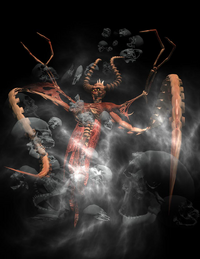| Mephisto | |
|---|---|

| |
| Title | Lord of Hatred Commander of the Hell forces on the Sanctuary |
| Gender | Male |
| Affiliation | Burning Hells |
| Relatives | Baal (brother) Diablo (brother) Lilith (daughter) Lucion (son) Rathma (grandson) Azmodan (brother) Belial (mentor) Andariel (sister) Duriel (brother) Auriel (lover) Tathamet (father) Tyrael (brother-in-law) Malthael (brother-in-law) Itherael (brother-in-law) Imperius (brother-in-law) Anu (father-in-law) |
| Status | Merged with Diablo's essence |
| Appearances | Diablo II The Veiled Prophet Diablo I Diablo III Diablo III: Reaper of Souls |
| ||||||||
Mephisto, Dul'Mephistos, The Lord of Hatred, is one of the three Prime Evils and the eldest of the Three. He is depicted as a cunning villain in the Diablo series, most notably Diablo II. The deity Mefis, the spirit of love in the church of the Triune, is in reality Mephisto. He is a great tactician and perhaps the most intelligent of the Three.[1]
He is the father of Lucion and Lilith, two powerful demons who've played important roles throughout Sanctuary's history. He rules over the Realm of Hatred in the Burning Hells.
History[]
Origin[]
Mephisto is one of Three; a Prime Evil, alongside his brothers Baal and Diablo. Mephisto was originally created from one of the seven heads of Tathamet along with the other Great Evils. Together with his two brothers he ruled over the Burning Hells for untold ages and led the armies of Hell against the Heavenly Host of the High Heavens.
The Sin War[]
The events of the Sin War had been left in the hands of Lucion, Mephisto's son, until his demise at the hands of Uldyssian. Mephisto did not make a direct appearance in the conflict until the very end after Uldyssian had single-handedly driven both the armies of Heaven and Hell from Sanctuary. As the Angiris Council considered what they'd seen and decided to let Sanctuary continue to exist, Mephisto appeared and proposed that a pact be sealed between between Heaven and Hell. The pact would ensure that neither Heaven nor Hell would intervene in the affairs and mortals, and as proof of the pact Mephisto "cast his mark" upon the rubble of the Cathedral of Light.[2] It is uncertain what that meant, but it seemed to be a sacrifice on Mephisto' part, and in return for it he was given custody of the defeated Inarius, whom he brought back with him to Hell.
The pact was later extended to also include a truce between Heaven and Hell as well, but the Three immediately sought to find a way to work around it. This was opposed by the Lesser Evils, primarily Azmodan and Belial, who both wished to preserve the truce. The schism led to a rebellion in Hell, where the Lesser Evils eventually succeded in banishing Mephisto and his brothers to Sanctuary, thus securing the truce. This led to the beginning of the Dark Exile.
The Dark Exile[]
As the Three appeared on Sanctuary they were very weak and roamed the world for forty years, spreading terror, destruction and hatred wherever they went. Eventually however the Horadrim, a united order of mages, was created by Tyrael to hunt down and imprison the Prime Evils. Mephisto was the first to be captured in Kehjistan, approximately 45 years after their exile began.[3] He is then taken to the city of Kurast, where the Zakarum church is entrusted with guarding him, where they bury him beneath the temple city Travincal.
Mephisto does not stay silent for long. He immediately begins to try and corrupt the priesthood and its archbishops. It is not known how long it took for him to accomplish this, but all eventually fell to his corruption save for Khalim, the Que-Hegan of the Zakarum. Mephisto instructed the other priests to kill him, and with the Que-Hegan dead Sankekur took his place. Sankekur would later, after Diablo and Baal reach his temple, become the mortal host for Mephisto.[4]
As Mephisto consolidated his hold over the Zakarum and the entirety of Kurast, he sent the archbishop Lazarus east with Leoric to establish a new base kingdom of the Zakarum faith in Khanduras. Lazarus was however also instructed that the town they were looking to establish as the capital, Tristram, was also where Diablo lay buried. Lazarus freed Diablo, leading up to the events of Diablo I and Diablo II.
Diablo II[]
Mephisto continued to strengthen his hold over Kurast, and by the time Diablo and Baal arrived to meet him in Travincal little except for fanatical Zakarum zealots remained. Together the Three opened a portal to Hell through which Diablo stepped through to once again secure their hold over the Burning Hells. Mephisto remained in Travincal, but was killed shortly thereafter by the heroes pursuing Diablo. The heroes then took his sousltone with them to Hell, where they smashed it at the Hellforge.
Current Whereabouts[]
Mephisto's soulstone was destroyed at the end of Diablo II, and he has been banished to the Abyss.[5] He does not make an appearance in Diablo 3, but he is one of the Great Evils who are sealed inside the Black Soulstone, used to subsequently reform Diablo as the Prime Evil.
Physical Appearance[]
Mephisto is clearly depicted in the Book of Cain as a hovering demon with large horns and four arms. He has a hip but no legs, and a tail hangs down as an extension of his spine.
In his movie sequence appearances in Diablo II and in the game, Mephisto appears as little more than a skeletal torso in a misty white cloud, although his skull appears almost alien. The body is Sankekur's, after he underwent a transformation similar to the Dark Wanderer into Diablo, but the look is very similar to that of the canonical lore.
He is further described in The Veiled Prophet as well, when he appears and brokers the treaty with the Angiris Council:
"... The shadow coalesced somewhat into a tall, macabre shape that instantly brought to Mendeln’s mind the monstrous morlu or, worse yet, their heinous master, Lucion, who, like Lilith, was also offspring of this sudden and dread visitor ...
... A green, scaly hand thrust forth from the shadow to condemn Inarius ...
... A hint of great, sharp teeth momentarily flashed into sight where the demon’s head should have been ..."[6]
He utilizes a blue energy, possibly connected to his blue Soulstone, in concordance with his brothers to open the Infernal Gate.
Powers and Abilities[]
Mephisto is a master tactician and schemer who delights in turning friends and allies against each other. True to his namesake, he hates everything and everybody, but his Hatred for Heaven outweights all other considerations, and he wields his hatred with the goal of obliterating Hell.[7] Some believe he is the foremost of the Three, for further information see Rulership.
More than any of the other Great Evils, Mephisto is connected to the undead. In Diablo I all undead were his minions[8], and in Birthright the morlu are revealed to be the servants of Mephisto:
The morlu. It was a word of power, two syllables steeped in the magic of the Primus’s sire. The morlu were more than just fanatical; they lived and breathed the desire of the Lord of Hatred. They did not sleep, anymore; they did not eat. All the morlu did was fight.[9]
This should not be confused with the incorrect notion that Mephisto himself is an undead. He is, just like his brothers, a demon.
He is also seen in the final scenes of The Veiled Prophet where he signs an agreement between Heaven and Hell, indicating that he has the power to negotiate in the name of his brothers and all of Hell if need be.
Retcons[]
In the original Diablo I manual, Mephisto was captured alongside Baal and buried beneath Aranoch[10] In Diablo II this was changed to Mephisto first being captured in Aranoch and then being transported to Kurast, where the Zarakum were given the task of safeguarding him. In Diablo III this has now been changed to him being captured in Kehjistan, hence his imprisonment in Kurast.[11]
Trivia[]
- Mephisto is a playable character in Heroes of the Storm.
Gallery[]
References[]
- ↑ Cain, Deckard., Book of Cain, page 23.
- ↑ Knaak, Richard A., The Veiled Prophet, page 333-334.
- ↑ http://eu.blizzard.com/diablo3/world/timeline.xml
- ↑ Cain, Deckard., Book of Cain, page 118.
- ↑ Cain, Deckard., Book of Cain, page 124.
- ↑ Knaak, Richard A., The Veiled Prophet, page 331-332.
- ↑ Cain, Deckard., Book of Cain, page 26.
- ↑ Blizzard Entertainment, Diablo I Manual, page 51.
- ↑ Knaak, Richard A., Birthright, page 132.
- ↑ Blizzard Entertainment, Diablo I Manual, page 66.
- ↑ http://eu.blizzard.com/diablo3/world/timeline.xml
| Demons | ||
|---|---|---|
| Prime Evils | Baal • Diablo • Mephisto | |
| Lesser Evils | Andariel • Azmodan • Belial • Duriel | |
| Notable Demons | Assur • Astrogha • Gulag • Thonos • Kabraxis • Lilith • Lucion • Xazax • Grimspike | |



